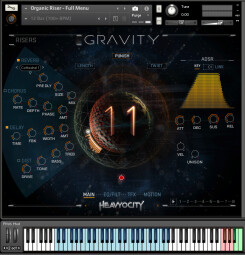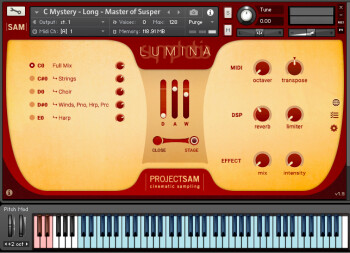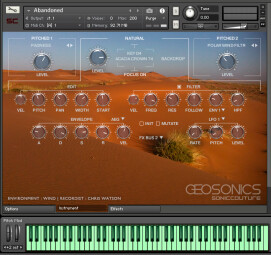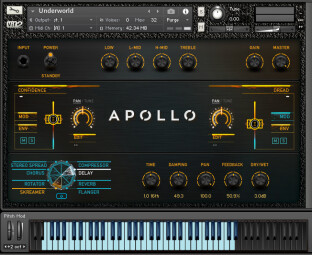Sampled audio collections have undergone significant change since polyphonic digital sampling first emerged in 1979. In the early days, the emphasis was on reproducing audio snapshots and then on entire instruments. A few years later, sampling short segments off records was all the rage, and it wasn’t long before entire musical vocabularies became available on CDs and eventually DVDs. Most recently, downloadable sample libraries have become a cost-effective means of getting the world’s finest sound designers to contribute their talents to your creative projects.
If you’re composing music for games, films or television, sample libraries can be enormous timesavers. When you’re scoring to picture, you often need to work quickly to meet unrealistic deadlines without compromising quality. Compared with using synthesizer presets or taking the time to create your own cues from scratch, sample libraries have a real edge when you need sounds that imbue your audio productions with cinematic sparkle.
For soundtrack work, especially, the libraries presented here are among the best I’ve found, but they can be useful for all kinds of music. All of the libraries run on the same platform, Native Instruments Kontakt, which has become the de facto standard for sample playback in most studios. If you don’t own the full version of Kontakt 5.5 (essential for any electronic musician), they also run in the current version of the free Kontakt Player.
Heavyocity Gravity (9GB, $449)
Heavyocity has been crafting sample libraries for television, film and game composers for the better part of a decade. Their creative team has distinguished itself as a source of extraordinary content designed for scoring soundtracks. Heavyocity employs some of the best sound designers in the business, and Gravity may be their best work ever.
Gravity’s gorgeous GUI offers many more pages than most other software instruments. It is designed to help you quickly locate and customize the sounds you need as soon as you need them. The collection’s greatest strengths are the sheer variety and quality of its content and the many ways you can modify that content. Gravity combines imaginative synthesizer programming with orchestral effects you’d be hard-pressed to pull off yourself, even if you had a lot of time, a lot of money, brilliant ideas and an orchestra at your beck and call.
With as many sounds for so many occasions as you’ll find here, it’s essential that the sounds be well organized. Gravity divides them into Hits, Pads, Risers and Stings, which are broken down into additional categories. Complex Pads, for example, can be aggressive, ethereal, experimental or unnerving. The risers shine brightest of all, with dramatic transitions galore. By playing different keyboard sections, you can easily split many sounds into their constituent elements and layer them in various combinations, all in real time. A motion sequencer lets you automate pitch, volume and pan modulation. You can specify sound lengths to suit any situation, and an assortment of effects is always on hand.
“Alien Landscapes”: Here’s an example of one of Gravity’s pads.

“15 Sec. Riser”: Gravity features an especially nice selection of risers.

Output Signal (20GB, $199)
When I first heard about Signal, I wondered, what the heck is a pulse engine, and what are pulse instruments? Is that some new synthesis technique? When I looked into it, I discovered that a pulse engine generates rhythmic control signals—in a word, pulses—to make sounds that, well, pulsate. Although Output would have you believe Signal introduces something radical and revolutionary, it simply puts a new name on a conventional idea and expands on it in ways no one else has. (Okay, maybe that is radical.) Signal is an excellent software instrument with a user interface that emphasizes rhythmically triggering samples and modulators with control signals. That approach greatly influences not only how it sounds, but also how you musically interact with the sounds it makes.
A Signal preset begins with two sound sources, Pulse Engine A and Pulse Engine B. Each engine lets you select a pair of multisamples from a menu of 25 acoustic instruments and 25 synthesized timbres. The instruments range from harp and upright bass to bowed piano and found percussion, and the synths range from simple analog sine waves to complex granular creations with names like Particles and Singularity. To soup up Signal’s samples, you can select from six filters and a nice assortment of effects processors.
Signal uses any two of four modulators called pulse types to trigger and modify parameters such as volume, filter cutoff, distortion, and panning. The Wave pulse type is an LFO with 45 waveshapes. The Step Sequencer type has up to 32 steps, and the Arp type is a 32-note arpeggiator. The Loop pulse type repeats the sample that’s currently playing while giving you the ability to adjust its length and start point, and it can stack identical samples playing the same pitch. All told, Signal is a collection of 500 factory presets that pulsate in more ways than you thought possible, while supplying the tools to customize the factory content and create your own using pulsating patches.
“Soo Epic”: Many Signal presets are electronic in nature.

“Echolalian Harpist”: Because half the samples are of acoustic instruments, it’s easy to make any of them pulsate.

ProjectSAM Symphobia 3: Lumina (43GB, $1,099)
For years, two of my favorite sample libraries have been Symphobia and Symphobia 2, both of which I can’t recommend highly enough for assembling dramatic and bombastic symphonic soundtracks rather quickly. The third edition of this series is Symphobia 3: Lumina. Lumina is similar to its predecessors, but it aims to help you assemble the musical underpinnings for mysteries, fantasies and cartoons. Six folders comprise six sound categories: Stories, Textures, Playable Instruments, Legato Soloists, Dystopia and Trio Ensemble Phrases.
The Stories category combines instruments thematically to give you 19 good starting points for composing scores, so you can focus on composing without spending too much time on orchestrating. Every element in a story is available in a single keyboard layout, so you can perform in real time while using keyboard zones, velocity layers, the mod wheel and key switching to vary which instruments are playing. Textures are a collection of 29 orchestral tone colors designed to impart specific moods. These include instrumental phrases, note clusters, risers, falls and a variety of classic orchestral effects.
Playable Instruments is comprised of 25 presets offering individual notes, chords and phrases sampled from numerous instruments and ensembles. Examples include a Celtic harp, a woodwind quartet, cartoon percussion and a 64-note bell tower. Legato Soloists provide 10 individual instruments, and they’re quite expressive. Most are woodwinds, along with a soprano voice and a trumpet. The Dystopia folder changes things up considerably, with sustained guitar tones, unusual or abrasive percussion, some darker instrumental effects and an excellent collection of Mellotron samples called Vintage Orchestra. Lumina’s recent update also includes Trio Ensemble Phrases, which provides chords, arpeggios and repeated phrases from woodwind, brass and string trios.
Admittedly, Lumina isn’t cheap, but if the alternatives are hiring musicians and spending months arranging your score or finishing the job in record time, you can afford it. No matter what, it will squeeze colors onto your timbral palette that you’d otherwise never have without substantial cost and effort. Isn’t that what sample libraries are all about?
“Fantasy – Mindfulness”: Lumina’s Stories make it easy to create cues by playing live on your keyboard.

“Mystery – Crescent Moon”: You’ll discover a range of moods in Lumina.

Soniccouture Geosonics ($149, 6GB)
You say you love nature sounds, but you don’t want to spend thousands of dollars schlepping your gear to the frozen Antarctic, bug-infested swamps or sun-scorched deserts? Geosonics, from 10-year-old London-based soundware developer Soniccouture, isn’t quite like anything else you’ve heard. This unique collection combines environmental recordings from far-flung locales with synthesized textures from top sound designers. If you’re looking for evocative pads that transport you to places far, far away, look no further.
Geosonics starts with field recordings from the BBC’s Chris Watson (ex-Cabaret Voltaire) and divides them into four instrument types. Soniccouture made Watson’s sounds musical by tuning them and layering them with pairs of pitched electronic timbres created by synthesists such as Ian Boddy and Biomechanoid. The Wires category features oscillating power lines and wind blowing across long stretches of wire fence in the Australian outback, among other sources. Ice and Water gives you hydrophone recordings from beneath glaciers and inside ice caverns, along with frozen slush, lapping waves, cracking ice, and all kinds of flowing water. Wind supplies wailing and whooshing gusts from the North Pole to the Kalahari Desert, and Swamps puts frog songs from Venezuela to Madagascar in your speakers.
“Wind – Dune Ghosts”: Geosonics combines the sounds of nature with electronic timbres.

“Wires – Another Frequency”: If you want to make your electronic music sound more organic, Geosonics can help.

Vir2 Apollo Cinematic Guitars ($300, 12GB)
By combining acoustic and electric sound-production techniques, electric guitars and basses are the modern world’s most prevalent electro-acoustic instruments. Their uniquely musical timbral qualities ensure their enduring popularity as each new generation of guitarists coaxes undiscovered sounds from them. Some of my favorite guitarists are adept at making their instruments sound like anything other than guitar. I especially appreciate players like Adrian Belew and David Torn who create unusual and atmospheric textures you just can’t achieve with other instruments. A new sample library from Vir2 Instruments delivers just these kinds of unconventional guitar sounds, many of which are genuinely cinematic in scope.
Apollo divides sounds into five folders: Instruments, Swells, Pads, Phrase Builder and Ambient Designer. Instruments supplies what you’d normally expect from an instrument sample library—individual notes, most with plenty of effects, many of them quite lovely. Swells gives you tons of chromatic notes and chords you control with your mod wheel. You may be surprised at the variety achieved using effects. The Pads category furnishes some beautifully evocative textures, with a range of moods suitable for calming your audience, lifting them up or making them tense. Each pad comprises two sampled sources, each with independent tuning and panning. They sound so nice, I’d recommend Apollo for the pads alone.
Phrase Builder provides a collection of licks, picked arpeggios and strummed chords you can trigger in sequence to create complete tracks. Ambient Designer is a single instrument that divides the keyboard into six sections. Each key triggers a different guitar tone, phrase, or sound effect you can latch to loop various combinations. All told, Apollo is significantly different from other guitar libraries and one that’s well worth exploring.
“Calm – Darkly”: Is it a guitar? Sometimes you can’t be sure.

“Abstract – Wahoo Wet”: Other times it can’t be anything but a guitar.

Geary Yelton is Electronic Musician’s former senior editor. He’s been writing for EM continually since 1985 and has also written for the U.S. magazines Keyboard and Mix. He authored two editions of The Rock Synthesizer Manual and served as staff synthesist for three major Atlanta recording studios. Currently, he’s a freelance writer and consultant for the Bob Moog Foundation in Asheville, North Carolina.





